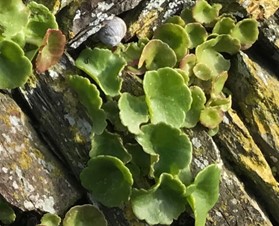Ethnobotany, at its most visible for the tourist, can be seen in local botanical gardens and ethnography museums. Consider for example, the Ljubljana Botanical Garden, Slovenia, established in 1810 and containing more than 4500 species, or the onion museum in Roscoff, France, whilst a seaweed collection company in Roscoff provides an example of entrepreneurship that combines knowledge management, research and locally available well-being products made from marine vegetation to create a new and growing business. Such collections, gardens and museums vary in their design, features and purpose, and, when recognized as flagship attractions, attract substantial numbers of tourists, for example, Kew Gardens in the UK or Monet’s Garden in France.

Image 1: Pennywort growing near the river Gannel in Newquay, Cornwall, UK. Pennywort is used in salads and stir-fried vegan meals. Traditional dry-stone walling for retaining terraces encourages the growth of pennywort – umbilicus rupestris. Photo: Dr C. Mansfield 11 March 2020.
Local councils and land management authorities, though, are best-placed to provide the macro-environment to protect plant diversity. In the literature, the relationship between plants and tourism is still neglected. Often city branding and newspaper travel journalism do not detect and disseminate ethnobotanical tourist offerings because research methods are still undeveloped, so a more sensitive method is needed to elicit this knowledge.
Plants for artisanal food production
Plants for artisanal food production at a local level is the first, most attractive integration of ethnobotany into the tourism value chain. Locally-occurring plants, or ones easily adapted to the climate, soil, knowledge and labour availability are of prime importance to local stakeholders in, for example, a seaside town which relies on its regional hinterland. Food from plant material offers local makers a safer choice than from animal sources because of the lower risk of food poisoning, and no viral transmission as experienced in the H1N1 virus from pork and chicken, the Ebola virus from meat and more recently SARS and Coronavirus COVID-19 after zoonotic events in wholesale food markets of animal products.
The heritage visitor centre or ethnopôle often presents tourists with a view of food production from before the introduction of the industrial Haber process in 1913 and oil-harvested cereal mono-cultures. In the UK, a prime example of a mono-culture is the planting of Italian ryegrass as a fodder crop for meat and wool production across the whole of the country. This grass provides the tourist destination image of Britain as a green and pleasant land. However, this is not a native species. The grass is harvested in a way to prevent tree growth and to suppress wild flower meadow plants that would maintain health in a range of species, including farmed animals, humans, and wildlife. It is an important example of tourist destination image being linked to a non-native plant species which offers a lesson in how more ethical approaches to planting and branding could be communicated in the visitor experience economy.
Finally, nectar-bearing plants for pollinators, for example, bees, offer no direct food source for humans and are thus neglected in commercial planting regimes. For sustainability and to go further to regeneration through carbon sequestration, tourism discourse practices need to find a way of making these plants attractive culturally. An example of this is Lily of the Valley, or Teardrops (‘solzice’ in Slovene), from a short story called ‘Solzice’ by Lovro Kuhar, which has symbolic value for the region in Slovenia.
Developing an Ethnobotany Checklist for Regenerative Tourism
The French heritage initiatives for regional tourism development, for example, Sites of Remarkable Taste, teach other tourism developers and tourism consultants that symbolic cultural capital needs research and committed content marketing in order to be noticed by stakeholders and the travelling public. To make this knowledge transferrable a checklist was created as a discovery instrument during the EU-funded Interreg V-A Slovenia-Croatia project KAŠTELIR. The checklist is for those who wish to identify plant and human connections and through this to make the local tourism offer more authentic, unique and more environmentally sustainable for their town and its region.
Culture and heritage can stimulate processes of rural and urban regeneration. In the making of places, creativity has become a significant strategy within tourism crucial for the implementation of various strategies, including literary travel writing, its methods and techniques. Just three creative examples from the ethnobotany research, presented below, illustrate how to implement the checklist, with suggestions and examples which literary travel writers could disseminate through their professional discourse practices in the industry.
Integrating Food Education Centre with Tourism
Macrobiotic food choice and preparation began in Japan and is dairy-free and sugar-free; using whole grains, vegetables, beans, tofu and tempeh, sea vegetables, seeds and nuts, fruits and natural sweeteners. An example of how this has been combined with tourism is the International Macrobiotic School in Devon, UK. This approach of offering education to visitors within the region becomes a tourist product which interprets the tourism space.
Wearable Botanics
Flax and hemp can both produce types of cloth for apparel-making and will grow in wetter, northern European climates, thus avoiding fabric-miles. Crailar is a natural enzyme-processed hemp fibre from Canada. Hemp clothing resists ultra-violet light and mould which makes it suitable for outdoor tourism pursuits. The hollow fibres prevent sweating odour for walkers and hikers. Hemp plants grow rapidly to produce over 5 tons of cellulose fibre per acre in four months. Hemp plants grown commercially sequester more carbon than many tree species.
Finding Plants in Toponyms
The river Gannel which separates Newquay in Cornwall from the suburb of Fistral derives its name from a Cornish word for the lovage plant, levisticum officinale. When tourism developers can find plant names in old place names a valuable starting point is established for recreating that botanical link. In Slovenia, many such place-names can be found in towns and villages: Kostanjevica is derived from the chestnut tree (kostanj in Slovene), Breznica is derived from the birch tree (breza in Slovene), and Slivnica for example originates from plum (sliva in Slovene). These names are of Slavic origin.

Dr. Charlie Mansfield is an RSA member and independent researcher in tourism management and travel writing.
Are you currently involved with regional research, policy, and development? The Regional Studies Association is accepting articles for their online blog. For more information, contact the Blog Editor at rsablog@regionalstudies.org.